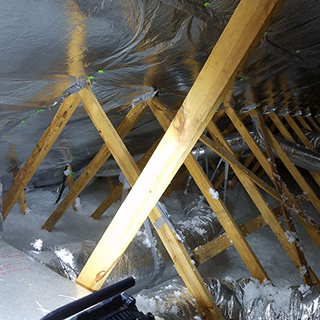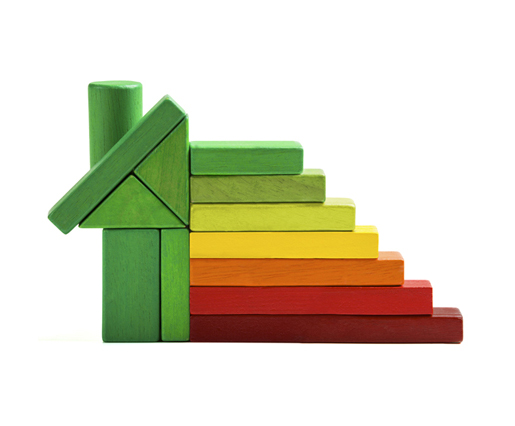- >CALL ☎
- >TEXT 💬
RADIANT BARRIERS
eShield™ radiant barrier is an innovative temperature control solution.
Beat the heat and save on energy bills with our professional radiant barrier installation service. Our reflective insulation shields your home from the main source of lost heat in homes.

WHAT IS eSHIELD™?
Reflective Foil Insulation - Thermal Protection for Roofs, Attics, & Walls
Able to stop more than 97-percent of radiant heat, eShield™ multilayer reflective foil insulation is an exceptionally efficient and innovative solution to thermal insulation needs. Most types of insulation protect against conduction and convection, measured by R-values.
However, they fall short of eShield™ when it comes to E-value, which measures radiant heat transfer, the main source of lost heat in homes. By coupling eShield™ with existing home insulation, you can create a complete solution to all types of heat transfer.
CREATING COMFORT
More moderate attic temperatures means less load on attic insulation, which results in lower ceiling temperatures in summer (and higher in winter). This directly results in more comfortable living spaces regardless of the temperature setting on your thermostat. This is achieved by reducing fluctuations in mean radiant temperature.
Comfort is influenced by both air temperature (convection) and the temperature of the surfaces around you (thermal radiation). Your thermostat controls the air temperature but has no way to measure or regulate "how it feels" in the house. Thermal radiation accounts for up to 2/3 of your body's ability to regulate temperature.
Just like windows and walls that get direct sun are always warmer, if warm surfaces are radiating heat onto your skin, your body can't cool down and you set the thermostat lower. Ideally, you want your walls and ceiling to be a few degrees warmer than your skin during the winter and a few degrees cooler in the summer.
eShield™ radiant barrier is specifically designed around radiant heat transfer. eShield™ installed in your attic and crawlspace works by reflecting out the radiant heat in the summer and reflecting back in the radiant heat in the winter. This results in more comfortable ceilings and floors, and therefore a more comfortable you.
HOW eSHIELD™ WORKS

The Radiant Heat Barrier
Improves temperature control | Reduces fluctuations | Increases efficiency
The multilayer foil insulation reflects up to 97% IR in both directions, helping to reject heat in the summer and retain heat in the winter.
eShield™ insulates HVAC equipment allowing for fewer air exchanges to reach target air temperatures resulting in lower utility bills.
More moderate attic temperatures with higher efficiency heating and cooling means greater overall comfort in your home.
ENERGY SAVINGS
eShield™ reduces ceiling heat flux by as much as 60%*
In the summer, the heat from the roof emits down through the attic into the living space. When eShield™ radiant barrier is installed in the attic, the infrared heat is reflected out before it can penetrate any further, reducing the temperature of the attic by as much as 30 degrees F.
With the attic cooler, the insulation below won't have to work as hard because it will be under a lighter load, and the A/C doesn't have to work as hard and won't have to cycle on as often to maintain the lower temperature.
eShield™ radiant barrier works best in the summer, but it also helps during the winter. The heat generated inside the living space needs to be prevented from escaping, especially at night when the temperatures drop the most.
As heat conducts to the drywall and attic insulation, the mass of those objects store and re-emit the heat in the form of infrared energy. eShield™ is the best solution because only a radiant barrier can reflect 97% of the infrared heat without losing its reflectivity over time.
* "Effects of Radiant Barrier Technology on Summer Heat Load in South Texas" R. Ashley, O. Garcia, M.A. Medina, and W.D. Turner. Proceedings of the 9th Symposium on Improving Building Systems in Hot and Humid Climates. Arlington, Texas. 1994. APPLIES TO ALL RADIANT BARRIERS DESIGNED IN ACCORDANCE WITH ASTM C1313
Convection, Conduction and Radiation
There are three primary ways a house loses/gains heat.
Before we can solve any potential issues, it is crucial to define and understand these factors:
Convectionis heat transferred by moving "fluid" (aka, air). Convection happens because of temperature and density differences in the air. For purposes of efficient comfort, convection refers to air leakage or infiltration/ex-filtration.
Conductionis heat transferred through solid objects and surfaces in contact with each other (aka, building envelope assemblies such as walls, ceiling, floors and windows). For the purposes of efficient comfort, conduction refers to insulation or R-value.
Radiationis heat flow from a higher temperature source to a lower temperature source within "line-of-sight" (aka, solar energy or infrared radiation). For purposes of efficient comfort, radiation refers to the solar heat of the sun.

The Energy Loss Trifecta
Learn more about the three primary ways a house loses and gains heat.
CONVECTION
Convection occurs 24/7/365 in our homes. Warmer air rises to the upper levels of the house and leaks out of cracks, gaps and seams in the ceiling and is lost to the outdoors. This lost air carries with it all of the energy it took to heat, cool, humidify, dehumidify, clean and purify it originally.
Nature abhors a vacuum. So, when air leaks out (ex-filtration), new air must leak in (Infiltration) to make up for the loss. This presents several issues for efficient comfort. Air leaking into the home carries dust, dirt, pollen, allergens and a bunch of other stuff that may not be desirable (aka, "bad air").
To compound the bad air problem, this infiltration is uncontrolled, meaning that it is leaking in from contaminants in the house. Air leaking in must also be "conditioned" (aka, heated, cooled, humidified, etc.). It is a vicious cycle: paying to condition the air that leaks out and then having to pay again to condition the air that leaks in - only to have it leak out over and over again.
Air leaks also present specific seasonal and geo-zone challenges as well. During the winter months, air leaking out (typically into unconditioned attics) carries moisture. This moisture will condense when it comes into contact with cold roof sheathing in the attic creating the potential for problems like mold. This warm air is also the primary cause of damaging ice dams as well. Cold air that is leaking in will immediately expand causing the concentration of water molecules along with it.
This will result in a very low relative humidity level in the infiltrated air. The net effect is lowering humidity levels in the homes which translates to both health and comfort issues for the homeowner. And, let's not forget the obvious challenge: cold air leaking into lower levels of the home usually evidences itself as "cold drafts" which is a common cold weather experience and complaint of homeowners.
During the summer the excessive infiltration can result in high humidity levels, smelly basements, mold and mildew. Hot and humid air is drawn into the home and immediately shrinks. This causes the concentration of water molecules in the air to become denser, resulting in very high relative humidity levels in this infiltrated air. In some circumstances air movements of cooler air dropping to the lower levels in the home can result in bad air from the attic being leaked in at the upper levels of the home.
CONDUCTION
Conduction is occurring in our homes whenever there is a temperature difference between the inside and outside or conditioned vs. unconditioned areas. The rate of heat transfer will be impacted by the amount of insulation combined with the temperature difference on each side of the construction assembly. More insulation, as expressed by higher R-values, will slow down the rate of heat flow. Less insulation, as expressed by lower R-values, will increase the rate of heat flow.
The higher the temperature difference between the conditioned space and the exterior or non-conditioned space, the greater the heat flow rate. The lower the temperature difference, the slower the rate of heat flow. The total amount of heat transfer due to conduction is also directly linked to the effective area of the specific construction assembly as well.
Generally speaking, when it comes to insulation - more is better. There are exceptions to the Law of Diminishing Returns. Following the Energy Star guidelines by geo-zone is recommended but with the caveat of prioritizing Implementation based on the specific circumstances of each house. Proper evaluation must take into account the locality of the assembly, R-value and effective area relative to other assemblies in the home.
Usually the upper level of a typical home or the ceiling assembly is the top priority.
- The ceiling in a typical house represents one of the largest effective areas.
- The temperature difference between the conditioned space and the attic is usually much more extreme than to just the outdoors.
- Based on Energy Star recommendations, the majority of existing attics are under-insulated. These factors would usually translate into upgrading attic insulation as a priority vs. upgrading wall insulation. Of course, there will be exceptions to every rule.
RADIATION
Radiation is often the forgotten, ignored or generally misunderstood component of heat flow. One of the reasons that thermal radiation is often misunderstood is that it does not require a medium for heat flow to occur like convection or conduction. Convection requires air flow. Conduction requires building assembly surfaces. Radiation occurs due to waves or rays (i.e. the rays of the sun).
The sun acts to heat up the roof of a home virtually all year long. As the construction assembly of the roof heats up, from shingles to the roof sheathing, the temperature of the sheathing will rise significantly above the outdoor ambient temperature.
The underside of the roof sheathing can seasonally reach well into the 140-degree to 150-degree range. Regardless of how excessively hot the roof sheathing gets, as soon as it reaches a temperature hotter than the objects below it the circumstances have been set up for thermal radiation to occur.
WHY CHOOSE US
PREMIER INSULATION
We start with a complimentary, in-home consultation with one of our licensed insulation experts. You will be quoted fair prices - with no hidden fees - and provided with a reasonable installation timeline from start to finish. Our estimates are sent directly to your email inbox, where you can see line-item pricing as well as terms and conditions.
We Keep Our Promises
Trust is the cornerstone of our long-term success. We have served thousands of happy clients and look forward to serving you!
YOU'RE IN GOOD HANDS
WE DO IT RIGHT
We show up on time, maintain a tidy job site and perform high-quality work.
WE DO IT SAFELY
Keeping you and your family safe is the most important thing we do.
WE STAND BEHIND OUR WORK
has the best warranties in the business.
WE GUARANTEE YOUR SATISFACTION
Frequently Asked Questions
Increased Comfort:
Insulation keeps your home warmer in winter and cooler in summer, creating a more comfortable year-round living environment. Sealing air leaks through proper insulation eliminates drafts.
Reduced Energy Costs:
By minimizing heat transfer, insulation saves energy, leading to significantly lower energy bills. With less work to do, your heating and cooling systems will run more efficiently, extending their lifespan and potentially reducing maintenance costs.
Environmental Impact:
Less energy consumption results in lower carbon dioxide emissions, contributing to a greener planet and combating climate change. Many insulation options are made from recycled materials or natural fibers, promoting sustainable practices in the construction industry.
Healthier Living:
Proper insulation can help control moisture levels, minimizing the risk of mold growth and promoting better indoor air quality for healthier occupants. Some insulation materials offer soundproofing benefits, minimizing unwanted noise from outside or between rooms within your home.
Additional Benefits:
A well-insulated home is generally more appealing to potential buyers, potentially fetching a higher price when you decide to sell. Certain insulation materials offer fire-resistant properties, adding an extra layer of safety to your home.
- Attic - The most crucial area for preventing heat loss.
- Walls - Improves overall home comfort and energy efficiency.
- Crawlspace - Reduces moisture and drafts, making your home warmer and healthier.
- Basement - Improves comfort and prevents cold floors.
- Floors - Provides warmth and reduces noise transmission.
The cost of insulation varies depending on the type of insulation, the size of the home, and the labor costs in your area. Call or fill out our contact form for a free estimate!
Several factors can indicate the need for new insulation, such as high energy bills, uneven temperatures in your home, drafty rooms, or visible signs of wear and tear on existing insulation.
The installation time depends on the size of the area and the type of insulation used. Most projects can be completed in a day or two.
Yes, we are fully licensed and insured for your protection.
